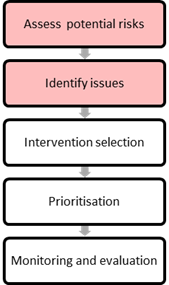10.1 INTRODUCTION
The assessment of potential risks and identification (or ‘diagnosis’) of issues are the first steps of the risk assessment process introduced in Chapter 9. Infrastructure Safety Management: Policies, Standards, Guidelines and Tools (Figure 10.1).

This chapter discusses methods for identifying high risk locations, and the ways that different sources of data can be analysed to assess the causes of this risk.
There are two main identification approaches that can be used by road safety engineers:
- The traditional approach used in the identification of risk is the analysis of historical crash data (reactive approach). This approach is still very relevant, but other sources of information used in the risk assessment process can lead to improvements and better results.
- The proactive approach (sometimes referred to as the systemic approach) relies on the analysis of physical and operational characteristics of existing roads or road projects to identify actual or future safety deficiencies. This approach is particularly useful in locations where crash data may be of poor quality and in locations where new infrastructure will be built. Proactive approaches are being increasingly used to supplement historical crash data. Furthermore, the added value of proactive approaches is the opportunity to improve infrastructure road safety before crashes happen and thus before road fatalities and injuries are recorded.
The focus of this manual is on the elimination of death and serious injuries, as these are the crash types that have the greatest societal impact. However, identification of high-risk locations involving death and serious injury does not just involve analysis of fatal and serious injury crash data. Other sources of information can also be used to identify likely locations where serious injury or death may occur.
The following section provides brief information on project- and programme-level approaches to risk assessment, while Section 10.3 Crash-Based Identification (‘Reactive’ Approaches) discusses crash-based methods for identifying and assessing risk and Section 10.4 Proactive Identification provides information on the proactive approaches, including Road Safety Impact Assessment (RSIA), Road Safety Audit (RSA) and Road Safety Inspection (RSI). Section 10.5 Combining Crash Data and Road Data brings both the reactive and proactive approaches together to discuss an integrated approach to assessing risk.
The development of effective safety treatments requires very good knowledge of the crash types and contributing factors and, more particularly, a good understanding of traffic, roadway and roadside features that are associated with increases in the exposure, likelihood, and severity of crashes. Expertise and experience, which allow the development of sound engineering judgment, are key elements in road safety improvement (road safety is often achieved from details).
Two levels of road infrastructure improvements, with differing budgetary impacts, can be identified:
- Network modernization: development of new infrastructures that are safer in design and operation (application of recent design standards, safety audits, etc.). This requires substantial investments.
- Improvement of the existing network through safety studies conducted at hazardous sites. Remedial measures are local in this case, such as improvement of an intersection, correction of a horizontal curve, removal of a roadside obstacle, etc. Investment requirements are less significant. But if they are to be fully effective, they must sometimes be supplemented or accompanied by measures applied elsewhere on the treated road (to prevent crash migration). This type of action is highly effective (see Section 11.4 Priority Ranking Methods and Economic Assessment).
In summary, to be really effective, road managers should implement a logical, continuous series of tasks, as described in the following Table 10.1.
| Tasks | Relevant measures Factors enabling effective action |
Knowledge of elementary factors | Data collection and management (crashes, traffic, road features) | Crashes: location, circumstances, profile of victims Traffic levels per user category, according to period and trip purpose Road features |
Observation of road users’ behaviour | Speed measurements Police statistics on offences Traffic cameras | |
Monitoring of road characteristics and users | Measurements of road surface roughness and skid resistance Surveys on users and local residents City planning processes | |
Safety diagnoses | Quantitative analysis | Statistics: crash indicators and rates Comparison with reference values High-risk location detection |
Qualitative analysis | Detailed crash analyses Sequential crash analyses Safety audits | |
Improvement studies | Planning | Road network typology Development of a road categorization system Coordination of transportation planning and urban planning |
Specific preventive/remedial improvements | Modification of elements on which the road manager can act:
Traffic flow management:
| |
Evaluation | Ex-ante evaluation | Evaluation of the existing situation and establishment of the safety objective for the future project (acceptable risk, targeted risk) |
Ex-post evaluation | Monitoring of the situation at road opening:
|
Each of these elements is described in further detail throughout this chapter.
How do I get started?
Guidance documents on the assessment of risk are available and should be adopted by all countries and embedded within core business. Training in the use of the following tools should be provided:
- Treatment of high crash locations (see Section 10.3 Crash-Based Identification (‘Reactive’ Approaches).
- Road safety impact assessments.
- Road safety audits.
- Road safety inspections
- Road assessment programmes (each is described in Section 10.4 Proactive Identification).
As a priority, assessment should be undertaken on high risk routes and corridors (see Belize case study in Section 10.2 Programme-Level and Project-Level Approaches), utilising crash data where available (Section 10.3 Crash-Based Identification (‘Reactive’ Approaches), as well as information on safety-related road elements (e.g. through safety audit and road assessment programmes – see Section 10.4 Proactive Identification).






